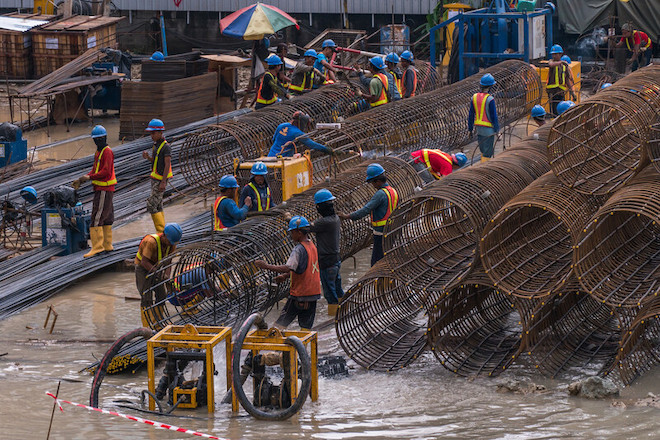
This article is published in collaboration with Mott MacDonald.
Specifications… pretty dull, right? Not PAS 2080, a set of specifications for buildings and infrastructure designed to empower businesses and organizations to reduce their carbon footprint. A global standard, PAS 2080 encompasses the whole life cycle of assets, and every part of the value chain. It brings carbon into all aspects of decision making, from investment planning and the development of design options, through construction and asset management to end-of-life disposal.
PAS 2080 provides a common framework, approach, governance, and language for carbon management, making it easier to set targets and incentives, and measure performance.
A ‘how-to’ guide
Creation of the specification was recommended in the UK government’s seminal Infrastructure Carbon Review, co-authored by Mott MacDonald and published in 2013. Mott MacDonald co-authored the first edition of PAS 2080, published by the British Standards Institution in 2016, and has co-authored the comprehensive update released in April 2023.
The update recognizes the urgent need for action. In 2021, the UN Environment Programme’s Infrastructure for climate action report found that the built environment is responsible for 79% of the world’s greenhouse gas emissions. Yet when the UK’s Green Construction Board reviewed the infrastructure industry’s progress on decarbonization, also in 2021, it reported the pace was slow and achievements disappointing. PAS 2080 equips organizations throughout the built environment to accelerate and do better on decarbonization.
Key features
- The world’s first and currently only specification for decarbonizing buildings and infrastructure systems.
- Sets out practical steps that clients and organizations across their value chain must take to reduce carbon.
- Promotes awareness of connections and interdependencies that can block or enable decarbonization across built environment systems.
- Demonstrates how to integrate carbon into decision making and procurement from project inception through to end of life.
- Empowers behavioral change by providing all organizations involved in infrastructure and building projects with a common framework for addressing carbon.
Promoting resilience
PAS 2080 explains the necessity of climate resilience alongside decarbonization: Measures designed, delivered, and operated to provide protection against the physical impacts of climate change must be net-zero carbon. Assets built as part of the transition to net zero must be resilient.
The update also warns that the world’s capacity for carbon storage is finite and potentially fragile—as increasingly common and destructive forest fires demonstrate. It urges organizations to seek a realistic balance between the carbon they produce and available carbon storage.
PAS 2080 draws attention to the co-benefits of carbon sequestration and biodiversity gain, whereby projects support a greater diversity and quantity of flora and fauna after completion than existed before. And it encourages the use of nature-based solutions where possible, as low or zero-carbon alternatives to conventional engineering.
Collaboration is critical
PAS 2080 illustrates the benefits of early collaboration between project parties, and their roles and responsibilities throughout the project life cycle.
What is more, it addresses decarbonization challenges that lie beyond owners’ direct control requiring that users map out the ways in which assets are part of interconnected and interdependent networks and systems.
Collaboration between organizations and across systems will be required to address "hard to cut" emissions and achieve reductions at the scale and pace required.
Strong leadership
Behavioral change is a key focus. PAS 2080 sets out the requirement for leadership from asset owners and all other members of the value chain. Through strong and effective leadership, carbon reduction must be embedded in organizational policy and strategy, with clearly assigned roles and responsibilities for delivery. Leadership is also essential for aligning commercial goals with strategic decarbonization goals.
The role of leadership extends to government, regulators, and investors, all of which have important roles in ensuring decarbonization is mainstreamed as a business risk and given due attention. PAS 2080 calls for coordination and collaboration vertically from top to bottom of the value chain, and horizontally within and between sectors.
The UK government was a world leader in 2019 when it made a legally binding national commitment to achieve net zero by 2050. To date over 240 other countries and cities around the world have done the same thing.
But unless the organizations that own, plan, design, build, operate, and care for buildings and infrastructure show leadership and drive the pace of decarbonization themselves, the 2050 goals will be missed.
Ambition alone is not enough, as Copenhagen has recently discovered. In 2012 it announced plans to achieve net-zero emissions but is likely to miss its 2025 target. Emissions targets must therefore be based on credible measures which are within the powers of those pledging them. PAS 2080 seeks to ensure that all stakeholders are coordinated in their approach so that all carbon reduction opportunities are discovered and aligned.
PAS 2080 is not a prescriptive checklist of things to do. It recognizes that there are very different conditions, challenges, opportunities and levels of maturity in decarbonization for every organization—and often within each organization. Its detailed guidance provides the means for all to accelerate progress.
This article was first published by Mott MacDonald.
 Maria Manidaki
Maria Manidaki
Technical Director–Decarbonization
Mott MacDonald
Maria Manidaki is a chartered engineer and a technical director for decarbonization at Mott MacDonald. She is an expert on infrastructure planning and decarbonization. She is the lead author of PAS 2080 (2016 and 2023) and co-author of the UK HM Treasury Infrastructure Carbon Review. She has worked with many infrastructure asset owners and their supply chains to help define their carbon management strategies and embed carbon management into infrastructure delivery programs. She is a member of the UK Green Construction Board and has been involved in various industry forums to help shape the decarbonization agenda. She is a visiting lecturer on sustainability and low-carbon practices at Cranfield University.

